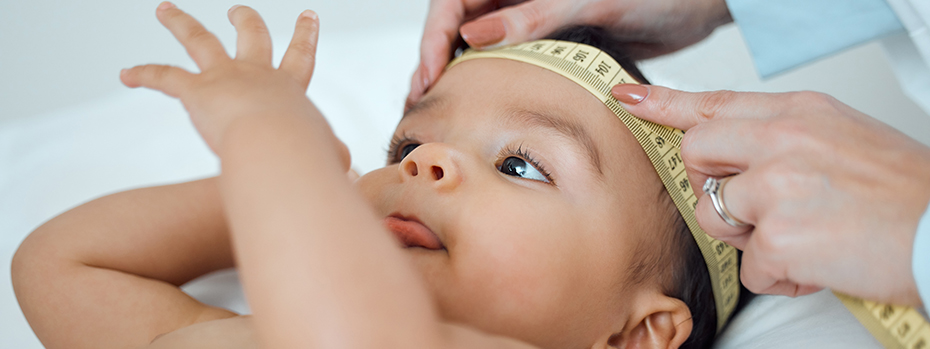Congenital Brain Anomalies

If your child has a brain anomaly, you’ll find care and support at OHSU’s Child Development and Rehabilitation Center.
The Congenital Brain Anomalies program offers:
- Deep experience: Our pediatric neurologist has evaluated and cared for children with congenital brain anomalies for many years.
- Continuity of care: You’ll have access to other specialists, clinics and programs to support your child’s growth.
- Family education: We will do our best to connect your family to support groups and research programs when appropriate.
Understanding congenital brain anomalies
What are congenital brain anomalies?
Congenital brain anomalies, also called brain malformations, are differences in brain development that appear before or at birth. The brain starts to form early in pregnancy. Its growth can be affected by genetic changes, environmental factors or infections.
What causes congenital brain anomalies?
Doctors often aren’t sure. Possible causes include:
- Genetic changes
- Infections or illness, such as Zika or rubella during pregnancy
- Exposure to toxins, such as harmful chemicals or drug use
- Trauma during pregnancy, such as the mother getting injured or a baby having a stroke before birth
Symptoms
Symptoms vary from mild to severe. They can include:
- Slow brain or head growth
- Larger brain or head
- Delayed speech or language
- Delayed or limited movement and muscle function
- Trouble swallowing or feeding
- Low muscle tone or stiff muscles
- Seizures or epilepsy
Location
OHSU Doernbecher Children’s Hospital, seventh floor
700 S.W. Campus Drive
Portland, OR 97239
Free parking for patients and visitors
Refer a patient
- Fax our CDRC referral form to 503-346-6854
- For help or provider-to-provider advice, call 503-346-0644 or 888-346-0644
Our services
Prenatal visits: Often, brain anomalies are diagnosed before birth. We work with OHSU’s Fetal Care Program to help you understand the diagnosis.
Complete care: At the CDRC, part of OHSU Doernbecher Children’s Hospital, you’ll get:
- A review of your child’s development and health
- Referrals to other specialists if needed
- Advice on what to expect as your child grows
- Recommendations for care and support of your child
Resources: We can connect you with social workers, parent support groups and researchers to learn more.
Our director
Dr. Joseph Pinter is a pediatric neurologist with more than 20 years of experience in caring for babies, children and teens, including those with rare and complex brain anomalies.
Conditions we care for
Agenesis of the corpus callosum: The brain’s corpus callosum, a large bundle of nerve fibers that connect the brain’s two sides, is fully or partly missing.
Cerebellar and other posterior fossa malformations: The cerebellum is a part of the brain at the lower back of the head. The posterior fossa is the part of the skull that holds the cerebellum and the brainstem, which connects the brain and spinal cord. Anomalies include:
- Chiari malformation: The cerebellum extends through the opening at the bottom of the skull. Chiari malformation often happens along with myelomeningocele, a type of spina bifida.
- Cerebellar hypoplasia: The cerebellum is smaller than usual or doesn’t develop fully.
- Rhombencephalosynapsis: The cerebellum’s two parts are not divided.
Holoprosencephaly: The front of the brain is not divided, or is only partly divided, into sides.
Lissencephaly: The brain has a smooth or mostly smooth surface instead of its usual wrinkles.
Macrocephaly: The head is larger than normal. This is not a disorder itself but the result of one. It is sometimes caused by hydrocephalus, a condition in which the brain has too much spinal fluid. Sometimes the brain itself is larger than usual.
Microcephaly: The head is much smaller than normal, or doesn’t grow properly. Microcephaly can be a sign of other brain disorders. Some children with microcephaly have smaller than usual but typical brains.
Porencephaly: The brain has one or more areas with small bags of spinal fluid (cysts). These can be caused by a stroke before birth; brain injury or damage; infection; or gene changes.
Schizencephaly: The brain has abnormal slits (clefts) in one or both sides. Symptoms depend on the location of clefts and their cause.
Septo-optic dysplasia: Common features of this condition include:
- Optic nerves are not fully developed.
- The brain is missing parts in the middle.
- The pituitary gland does not develop properly.
These can lead to:
- Low vision or blindness
- Intellectual delays
- Low or high muscle tone
- Seizures
- Pituitary disorders
Ventriculomegaly: Parts of the brain that hold fluid are too big. This condition can be linked to other brain anomalies, including hydrocephalus, a condition in which the brain has too much spinal fluid.
Related clinics and services
Fetal Care Program: Some brain anomalies are diagnosed during pregnancy. We work with fetal specialists to give you the most accurate diagnosis and help you know what to expect.
Neurodevelopment clinic: Some of our patients also attend this clinic. The team includes:
- Audiologists, to help with hearing
- Neurologists, for care of the brain, spinal cord and nervous system
- Occupational therapists, to help with daily activities
- Developmental pediatricians, to help with differences in growth and development
- Physical therapists, to help with movement
- Speech-language pathologists, to help with language
Pediatric diagnostic imaging: We can detect even subtle brain anomalies through:
- MRI
- Ultrasounds
Pediatric Epilepsy Center: We have Oregon’s most advanced care for children with complex seizure disorders.
Spina Bifida Program: We have Oregon’s only program with full care for children with spina bifida.
Pediatric neurosurgery: Doernbecher is a national leader in neurosurgery for children.